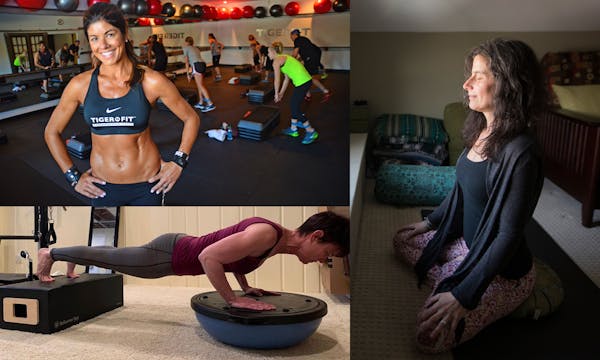Your gym is closed and you may not have a treadmill, rowing machine or a CrossFit instructor in your basement.
Still, you probably have a pair of decent shoes and a sidewalk, street or trail nearby. That's all you need to take part in one of the best exercises around: walking.
Yeah, walking.
"It's absolutely an exercise, and one that the more you put into it, the more you get out of it," said John Long, owner of Fleet Feet Minneapolis.
Since the stay-at-home order was put in place, walking has exploded in popularity.
"Walking is up 8,000% from what it was a month ago," said Long. "Everybody is getting outside."
That's the beauty of it, said Michele Stanton, a professional walking coach and author of "Eat Up, Slim Down."
"Everyone can do it," she said. "You don't need special equipment, you can do it anywhere and it's considered a moderate-intensity activity."
The benefits of walking are myriad and proven, said Stanton.
"There's tons of research showing the benefits of walking: It reduces heart disease, stress and the risk of some cancers," she said.
It also results in fewer injuries than higher-intensity exercises, such as running.
But, as Stanton likes to say, "There's more than one way to walk."
"You can go for a leisurely walk, even a slow, meditative one, or you can make it a real workout," she said.
Make good better
Long and Stanton agree that anyone will benefit from any walking they do, be it a 5-minute midday break or a 45-minute power walk. But there are a few simple ways to make walking more beneficial.
If you haven't been getting much exercise, start slow.
"A 20-minute walk is a good thing," said Long. "If you're fairly fit, 30 to 40 minutes is probably about right."
More important than the length of your walk is the consistency.
"Keep it consistent," said Long.
Set a schedule and try to maintain it, whether that means a brief walk every day or a longer walk three times a week. You always can work your way to longer and more frequent walks.
If you're already fairly fit, work on your pace.
"Be mindful of your pace and vary it," said Long. "Maybe choose a route that has hills or go off-trail."
Walking faster isn't about a longer stride. Instead, Stanton recommends you try these things to improve your form:
• Bend your arms rather than keeping them straight.
• Instead of lengthening your stride, make it shorter, lift your knee (as you would if you were marching) and put your lead foot only about 4 to 5 inches in front of your back foot.
• Aim for a smooth stride by landing on your heel, rolling through and pushing off with the ball of your foot and your toes.
• Stand tall, roll your shoulders back, lift your chest and, if you're on consistent terrain, look out 10 to 20 feet in front of you rather than down.
You may want to try intervals of faster-paced walking or running, alternating with a slower walk.
"Intervals are a great way to get your heart rate up," said Stanton.
Try increasing your pace for 30 seconds, then recover for the next 60 seconds.
Long suggests creating your own circuit workout, alternating walking, running and some simple exercises like squats, lunges, pushups or situps.
Buddy and soul
Of course, any exercise is only partly about your body. Lots of us also crave the social connection that a gym class or a running group offers. And that turns out to be a good thing.
"Having a buddy increases the likelihood you're going to stick to it," Stanton said. "Right now, that might mean bringing a cellphone," popping in your earbuds and talking to a pal.
You also can find a friend or family member to walk with, as long as you maintain the prescribed 6-foot separation.
If being chummy doesn't work for you, engaging in a little competition might. If that's the case, there are plenty of ways to keep yourself motivated, said Long.
Consider setting up a virtual challenge with a friend or joining one online. Everwalk, Fitbit and MyFitnessPal are among the sites that offer online challenges in tracking steps, miles or time spent walking.
Another thing that might keep you walking? The payoff.
"Pay attention to the benefit you're getting," advised Stanton.
"Say you had a tough day at work and you feel down. You'll likely be in a better mood after you take a walk," she said.
You're also likely to feel better, eat better and sleep better.
Even though we're stuck at home, "our bodies," she said, "were meant to move."
Connie Nelson • 612-673-7087 • @StribCNelson
Body camera video shows Minnetonka man shooting at deputies several times before dying in firefight
Charge: Driver going 77 mph ran red light, fatally hit man crossing St. Paul street and kept going
Minnesota Senate GOP files ethics complaint against Sen. Nicole Mitchell
High school archer focuses on target: another national championship

